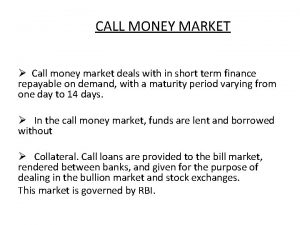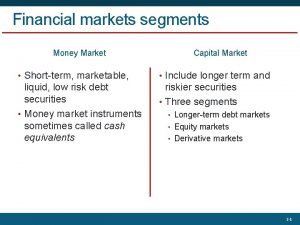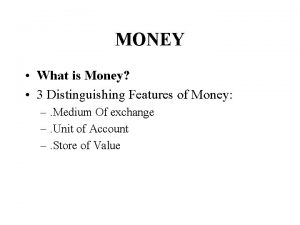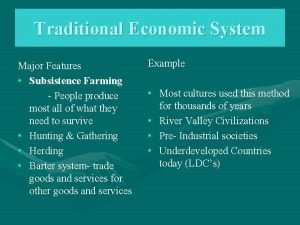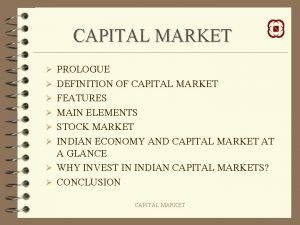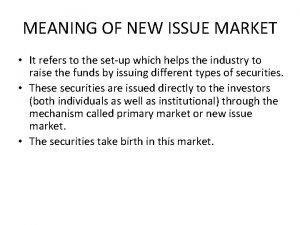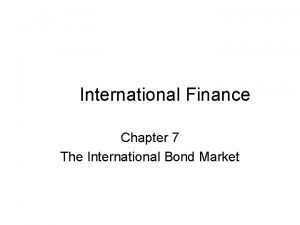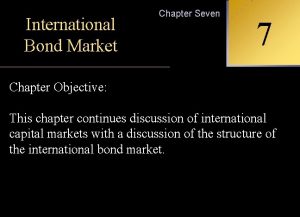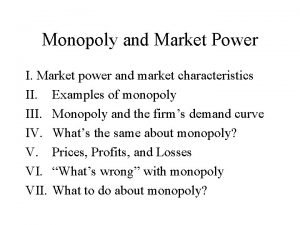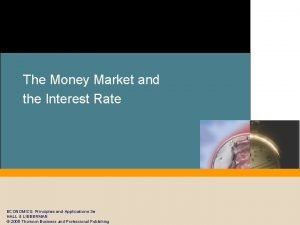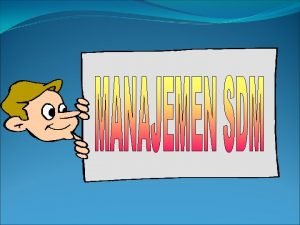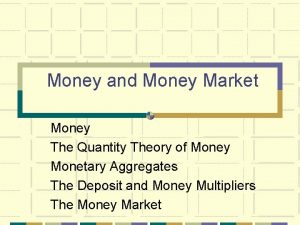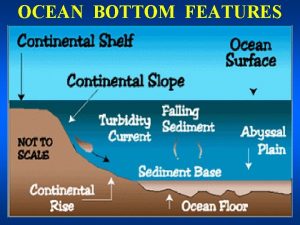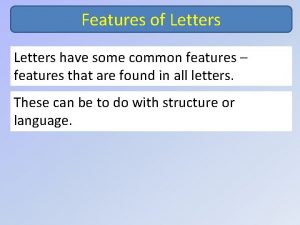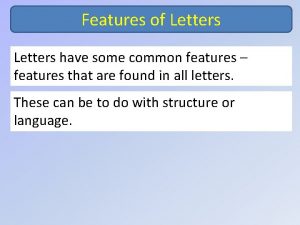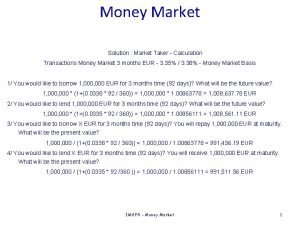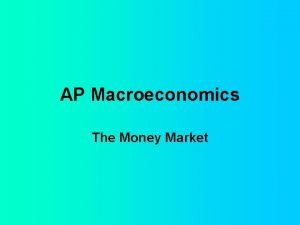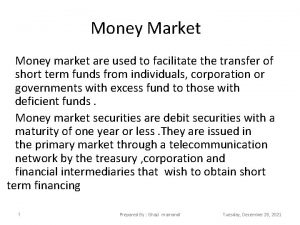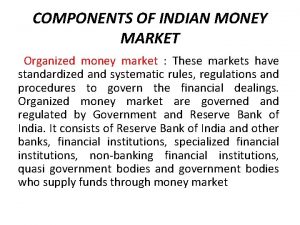MONEY MARKET CONTENTS What is Money Market Features
























- Slides: 24

MONEY MARKET

CONTENTS Ø What is Money Market? Ø Features of Money Market? Ø Objective of Money Market? Ø Importance of Money Market? Ø Composition of Money Market? Ø Instrument of Money Market? Ø Structure of Indian Money Market? Ø Disadvantage of Money Market?

Continued……. Ø Characteristic features of a developed money Market? Ø Recent development in Money Market? Ø Summary

1! What is Money Market? As per RBI definitions “ A market for short terms financial assets that are close substitute for money, facilitates the exchange of money in primary and secondary market”. • The money market is a mechanism that deals with the lending and borrowing of short term funds (less than one year). • A segment of the financial market in which financial instruments with high liquidity and very short maturities are traded.

Continued……. • It doesn’t actually deal in cash or money but deals with substitute of cash like trade bills, promissory notes & govt papers which can converted into cash without any loss at low transaction cost. • It includes all individual, institution and intermediaries.

2 ! Features of Money Market? • It is a market purely for short-terms funds or financial assets called near money. • It deals with financial assets having a maturity period less than one year only. • In Money Market transaction can not take place formal like stock exchange, only through oral communication, relevant document and written communication transaction can be done.

Continued……. . • Transaction have to be conducted without the help of brokers. • It is not a single homogeneous market, it comprises of several submarket like call money market, acceptance & bill market. • The component of Money Market are the commercial banks, acceptance houses & NBFC (Nonbanking financial companies).

3 ! Objective of Money Market? • To provide a parking place to employ short surplus funds. term • To provide room for overcoming short term deficits. • To enable the central bank to influence and regulate liquidity in the economy through its intervention in this market. • To provide a reasonable access to users of short-term funds to meet their requirement quickly, adequately at reasonable cost.

4 ! Importance of Money Market? o Development of trade & industry. o Development of capital market. o Smooth functioning of commercial banks. o Effective central bank control. o Formulation of suitable monetary policy. o Non inflationary source of finance to government.

5 ! Composition of Money Market? Money Market consists of a number of submarkets which collectively constitute the money market. They are, v. Call Money Market v. Commercial bills market or discount market v. Acceptance market v. Treasury bill market

6 ! Instrument of Money Market? A variety of instrument are available in a developed money market. In India till 1986, only a few instrument were available. They were • Treasury bills • Money at call and short notice in the call loan market. • Commercial bills, promissory notes in the bill market.

New instrument Now, in addition to the above the following new instrument are available: v Commercial papers. v Certificate of deposit. v Inter-bank participation certificates. v Repo instrument v Banker's Acceptance v Repurchase agreement v Money Market mutual fund

Treasury Bills (T-Bills) • (T-bills) are the most marketable money market security. • They are issued with three-month, six-month and one-year maturities. • T-bills are purchased for a price that is less than their par(face) value; when they mature, the government pays the holder the full par value. • T-Bills are so popular among money market instruments because of affordability to the individual investors.

Certificate of deposit (CD) • A CD is a time deposit with a bank. • Like most time deposit, funds can not withdrawn before maturity without paying a penalty. • CD’s have specific maturity date, interest rate and it can be issued in any denomination. • The main advantage of CD is their safety. • Anyone can earn more than a saving account interest.

Commercial paper (CP) • CP is a short term unsecured loan issued by a corporation typically financing day to day operation. • CP is very safe investment because the financial situation of a company can easily be predicted over a few months. • Only company with high credit rating issues CP’s.

Repurchase agreement (Repos) • Repo is a form of overnight borrowing and is used by those who deal in government securities. • They are usually very short term repurchases agreement, from overnight to 30 days of more. • The short term maturity and government backing usually mean that Repos provide lenders with extreamly low risk. • Repos are safe collateral for loans.

Banker's Acceptance • A banker’s acceptance (BA) is a short-term credit investment created by a non-financial firm. • BA’s are guaranteed by a bank to make payment. • Acceptances are traded at discounts from face value in the secondary market. • BA acts as a negotiable time draft for financing imports, exports or other transactions in goods. • This is especially useful when the credit worthiness of a foreign trade partner is unknown.

7 ! Structure of Indian Money Market? I : - ORGANISED STRUCTURE 1. Reserve bank of India. 2. DFHI (discount and finance house of India). 3. Commercial banks i. Public sector banks SBI with 7 subsidiaries Cooperative banks 20 nationalised banks ii. Private banks Indian Banks Foreign banks 4. Development bank IDBI, IFCI, ICICI, NABARD, LIC, GIC, UTI etc.

Continued…. . II. UNORGANISED SECTOR 1. Indigenous banks 2 Money lenders 3. Chits 4. Nidhis III. CO-OPERATIVE SECTOR 1. State cooperative i. central cooperative banks Primary Agri credit societies Primary urban banks 2. State Land development banks central land development banks Primary land development banks

8 ! Disadvantage of Money Market • Purchasing power of your money goes down, in case of up in inflation. • Absence of integration. • Absence of Bill market. • No contact with foreign Money markets. • Limited instruments. • Limited secondary market. • Limited participants.

9 ! Characteristic features of a developed money Market? q. Highly organaised banking system q. Presence of central bank q. Availability of proper credit instrument q. Existence of sub-market q. Ample resources q. Existence of secondary market q. Demand supply of fund

10 ! Recent development in Market Money ü Integration of unorganised sector with the organised sector ü Widening of call Money market ü Introduction of innovative instrument ü Offering of Market rates of interest ü Promotion of bill culture ü Entry of Money market mutual funds ü Setting up of credit rating agencies ü Adoption of suitable monetary policy ü Establishment of DFHI ü Setting up of security trading corporation of India ltd. (STCI)

11 ! Summary • The money market specializes in debt securities that mature in less than one year. • Money market securities are very liquid, and are considered very safe. As a result, they offer a lower return than other securities. • The easiest way for individuals to gain access to the money market is through a money market mutual fund. • T-bills are short-term government securities that mature in one year or less from their issue date. • T-bills are considered to be one of the safest investments.

Continued……. • A certificate of deposit (CD) is a time deposit with a bank. • Annual percentage yield (APY) takes into account compound interest, annual percentage rate (APR) does not. • CDs are safe, but the returns aren't great, and your money is tied up for the length of the CD. • Commercial paper is an unsecured, short-term loan issued by a corporation. Returns are higher than T-bills because of the higher default risk. • Banker’s acceptance (BA) are negotiable time draft for financing transactions in goods. • Repurchase agreement (repos) are a form of overnight borrowing backed by government securities.
 Dana damian
Dana damian Capital market and money market
Capital market and money market Fbl cheque in call money market
Fbl cheque in call money market Features of money market
Features of money market How to find bond equivalent yield
How to find bond equivalent yield Market follower
Market follower Segmentation levels
Segmentation levels Money features
Money features Motifs in the great gatsby
Motifs in the great gatsby Money smart money match
Money smart money match Money on money multiple
Money on money multiple Great gatsby historical context
Great gatsby historical context Tom buchanan character traits
Tom buchanan character traits Economic system features
Economic system features Features of capital market
Features of capital market Function of new issue market
Function of new issue market Types of bonds in international finance
Types of bonds in international finance Features of international bond market
Features of international bond market Foreign exchange market features
Foreign exchange market features Features of monopoly market
Features of monopoly market Characteristics of monopoly market
Characteristics of monopoly market Money market equilibrium
Money market equilibrium Money market participants
Money market participants Expansionary monetary policy effects
Expansionary monetary policy effects Man money
Man money


